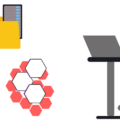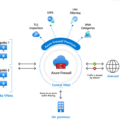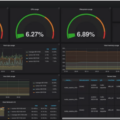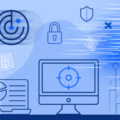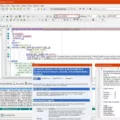Cloud monitoring is an essential part of any cloud-based infrastructure. It allows users to monitor their servers, applications, websites, and other cloud resources in order to ensure they are operating efficiently and meeting service-level agreements (SLAs). With cloud monitoring, organizations can identify potential security risks, analyze costs, detect issues before they become outages, and optimize performance.
The right cloud monitoring platform can help you ensure your IT infrastructure is performing optimally and effectively. Here are some of the top system monitoring software platforms available:
Zabbix – Zabbix is a free open-source monitoring tool that provides complete visibility into your entire IT infrastructure. It provides real-time insights into server performance and availability as well as application metrics.
Spiceworks Network Monitor – Spiceworks Network Monitor provides comprehensive network visibility and performance analytics for better IT decision-making. It offers a unified view of your network with real-time analytics on key performance indicators (KPIs).
Nagios – Nagios is a popular open-source system monitoring tool that helps you monitor the availability and performance of your IT infrastructure components such as servers, switches, applications, services, etc. It also includes features for reporting and alerting as well as automated remediation capabilities.
OpManager by ManageEngine – ManageEngine’s OpManager is an integrated network management solution that offers comprehensive device management across physical, virtual, and cloud systems from one console. It provides end-to-end visibility with root cause analysis for improved troubleshooting capabilities.
WhatsUp Gold – WhatsUp Gold is an all-in-one network discovery and monitoring solution for physical or virtual networks that delivers real-time insights into critical KPIs such as CPU utilization and memory usage.
Cacti – Cacti is an open-source network graphing solution that helps you graph historical trends in your network data over time to give you better insight into how your networks are performing.
Icinga – Icinga is an open-source activity monitoring system that helps organizations automate their activities by tracking activities across multiple systems in real-time. It allows administrators to set up thresholds so they can be alerted when certain conditions are met or exceeded before they become outages or critical events.
Veeam ONE– Veeam ONE is a comprehensive suite of tools designed to provide deep visibility into the health of vSphere environments including server health monitors, capacity planning dashboards, patch management tools, and more.
Site24x7– Site24x7 offers comprehensive application performance management (APM) solutions for web applications hosted on public clouds or private data centers including Amazon Web Services (AWS), Microsoft Azure, etc., helping organizations maintain the highest levels of application uptime for their customers and users alike.
Datadog– Datadog offers a powerful SaaS-based real-time analytics platform that enables businesses to collect metrics from various sources like cloud services like AWS & Azure, containers, microservices, databases, etc., providing them with actionable insights so they can quickly troubleshoot issues related to their apps & services before it affects the customer experience.
Dynatrace– Dynatrace provides an automated full-stack AI-powered observability platform that enables companies to proactively monitor the health & performance of their digital products & services across hybrid environments including public clouds, on-premise datacenters, containers & microservices.
Instana – Instana helps companies automate the process of managing modern application environments by providing deep observability into the underlying infrastructure & application components. They offer solutions for managing Kubernetes clusters, distributed tracing, anomaly detection & root cause analysis.
New Relic – New Relic’s cloud-based APM platform helps organizations quickly diagnose production issues affecting user experience with its highly scalable architecture. It also includes features like anomaly detection, distributed tracing, alerting & notification capabilities.
Amazon CloudWatch– Amazon CloudWatch provides real-time operational visibility into Amazon Web Services (AWS) resources such as EC2 instances, ECS containers, S3 buckets, etc., allowing users to monitor resource utilization & detect potential issues early on.
By leveraging these cloud monitoring solutions businesses can gain valuable insights into how their IT infrastructure is performing while also reducing operational costs associated with manual processes like troubleshooting outages & unplanned downtime. This not only improves overall customer satisfaction but also ensures the smooth functioning of business operations in today’s increasingly digital world.

The Benefits of Using a Cloud Monitoring Platform
A cloud monitoring platform is a system that provides visibility into the performance, availability, and usage of cloud infrastructure. It enables organizations to take control of their IT environment by monitoring various metrics like CPU utilization, memory usage, disk space, network bandwidth, and more. The platform gathers data from multiple sources such as servers, virtual machines (VMs), containers, and other components in the cloud environment. It then presents this data in real-time dashboards and reports to help administrators quickly identify problems and optimize performance. Additionally, some cloud monitoring platforms also offer automated alerts that can be configured to notify administrators when predetermined thresholds are exceeded or when an issue occurs. With a cloud monitoring platform in place, organizations can ensure their cloud-based applications remain available and running at peak performance levels.
Recommendations for Cloud Monitoring Services
I would recommend the following cloud monitoring services:
1. Dynatrace: Dynatrace provides automated monitoring of cloud applications, infrastructure, and services. It helps you identify performance issues in real time and gives you insights into your cloud environment. Its AI-based analytics engine automatically tracks changes in your application and infrastructure performance, enabling you to take proactive measures before an issue escalates.
2. Datadog: Datadog is a comprehensive cloud monitoring solution that offers real-time visibility across all of your cloud infrastructure and applications. It provides detailed metrics and insights into each component of your system, allowing you to quickly identify any potential issues or bottlenecks. It also features built-in alerting and automation capabilities to help you keep your systems running optimally.
3. LogicMonitor: LogicMonitor is a scalable cloud monitoring solution that gives you a unified view of all your cloud resources, including servers, networks, services, and applications. Its advanced features such as custom dashboards, alerting rules, reporting tools, and API integrations allow for deep visibility into the state of your environment so that you can detect problems early on.
4. Instana (an IBM Company): Instana is an AI-driven cloud monitoring platform designed to provide operational visibility into modern distributed applications running in the cloud. It offers real-time insights into application performance across all components and layers via automated instrumentation that captures details about every single request from end users’ browsers all the way down to the underlying services in the data center or public clouds.
5. New Relic: New Relic is another popular choice for monitoring cloud infrastructure performance with its comprehensive suite of tools for tracking application performance metrics such as response time and throughput along with server health metrics like CPU utilization and memory usage. The platform also provides powerful alerting capabilities so that administrators are notified when something requires attention right away!
6. Amazon CloudWatch: Amazon CloudWatch is a managed service offered by Amazon Web Services (AWS) that allows customers to monitor their AWS resources from one central location in real-time through its dashboard or API calls from other applications or scripts running on AWS resources such as EC2 instances or Lambda functions. CloudWatch provides detailed metrics about various components in your system such as CPU utilization, network traffic, etc., enabling administrators to quickly identify performance issues before they become a problem for users or customers!
7. Veeam ONE: Veeam ONE is an enterprise-grade monitoring solution designed specifically for virtualized environments running on VMware vSphere or Microsoft Hyper-V platforms. It helps organizations proactively monitor their IT infrastructure by providing key performance indicators (KPIs) related to virtual machine health and availability along with comprehensive reports detailing resource utilization trends over time which can be used to identify areas where optimization may be needed!
8. Site24x7: Site24x7 is an advanced cloud service monitoring platform that offers extensive insights into how well customers’ websites are performing across different regions around the world as well as various browsers and devices used by visitors accessing them from different locations -allowing them to act quickly if any critical issues arise!
9 .AppDynamics: AppDynamics is an application performance management (APM) tool designed to help organizations monitor the performance of their applications running on various public clouds like AWS & Azure as well as private clouds such as OpenStack & VMware vSphere environments with ease! AppDynamics’ highly scalable architecture lets administrators track detailed information about each component within their system in order to diagnose any potential issues quickly & efficiently before they become a problem for end users!
10 .SolarWinds Server & Application Monitor: SolarWinds Server & Application Monitor (SAM) is a powerful yet affordable software suite tailored specifically towards IT professionals looking for efficient ways to manage their complex IT infrastructures without breaking the bank! SAM’s intuitive interface makes it easy for administrators to visualize key metrics associated with network devices & applications while its advanced reporting capabilities enable them to produce detailed reports which can be used for further analysis & troubleshooting purposes!
Benefits of Cloud Monitoring
Cloud monitoring is a feature that allows you to keep track of your cloud-hosted applications and services. This includes monitoring performance, security, capacity, and cost.
Performance: Cloud monitoring allows you to ensure your cloud-hosted applications are performing within their SLA. This includes tracking response times, availability, throughput, and resource utilization.
Security: Cloud monitoring provides you with the ability to detect potential security risks in your cloud environment. It can help detect possible threats such as malicious attacks or unauthorized access.
Capacity: Through cloud monitoring, you can identify any capacity issues in your cloud environment so that they can be addressed promptly. You can also monitor usage patterns over time to anticipate future needs.
Cost: Cloud monitoring enables you to analyze costs associated with your cloud infrastructure so that you can make informed decisions about budgeting and scaling up or down accordingly.
The Best Software for Monitoring
The best software for monitoring depends on the individual needs of the user. For many, Zabbix is a top choice due to its expansive feature set and scalability. It offers agentless monitoring, alerting, and reporting capabilities along with a wide range of integrations. Spiceworks Network Monitor is also an excellent option for IT departments that need to monitor their network infrastructure, as it provides detailed analytics and reports. Nagios is another popular choice for monitoring IT infrastructures, offering powerful performance metrics and alerting options. For small businesses or those needing remote monitoring capabilities, ManageEngine’s OpManager is also a great choice. It provides an intuitive GUI along with comprehensive asset management features, such as the automatic discovery of devices in the network. Other options include WhatsUp Gold, Cacti, and Icinga for their respective strengths in network performance monitoring and application performance management. Finally, OpenNMS is another great option for those wanting open-source network management capabilities. Ultimately, the best software solution will depend on the specific needs of the user or organization.
Understanding Cloud Monitoring in AWS
Cloud monitoring in AWS is the process of collecting and analyzing data from cloud-based resources such as Amazon Web Services (AWS) in order to gain insight into the performance, health, and usage of those resources. It involves tracking different metrics from your AWS environment such as CPU utilization, disk space, bandwidth usage, memory usage, and more. This data can then be used to create reports that help you identify areas for improvement or detect potential issues before they become problems. Cloud monitoring in AWS can also be used to set up automated alerts so you are notified immediately when there is an issue with your cloud resources. With cloud monitoring in AWS, you can ensure that your applications and infrastructure are running optimally at all times.

Source: gepowerconversion.com
Understanding How Cloud Monitoring Works
Cloud Monitoring helps you collect, store, and analyze performance information from Google Cloud services and other third-party applications. It uses agents to collect system and application metrics, then stores the data in a data warehouse. You can view the data in both real-time and historical contexts.
Cloud Monitoring also provides alerting features that allow you to set up notifications for when certain conditions are met. For example, you can create an alert that will notify you when your website experiences a sudden spike in traffic or when your server is running out of disk space.
Another feature of Cloud Monitoring is its ability to detect anomalies in your system so that you can quickly identify and address any potential issues before they become problems. Finally, it provides comprehensive reporting tools that let you analyze the performance of your system over time, allowing you to make informed decisions about how to improve it.
Benefits of Cloud Monitoring
Cloud monitoring is an invaluable tool for businesses that rely heavily on cloud-based applications and networks. By actively monitoring cloud performance, businesses can improve the security of their cloud applications and networks, simplify the implementation of continuity plans, and proactively address risk remediation. Cloud monitoring also helps businesses to achieve and maintain ideal application performance.
Through the use of real-time analytics, detailed reporting, and automated alerts, cloud monitoring provides a clear overview of how well an application or network is running. This makes it easier for businesses to identify any potential issues before they become serious problems. Additionally, with real-time data available from cloud monitoring tools, businesses can quickly respond to any changes in their environment without having to manually investigate each issue. This ensures that systems remain secure and operate optimally at all times.
Conclusion
In conclusion, cloud monitoring is an invaluable tool for both large and small businesses. It allows organizations to ensure their cloud-hosted applications are running optimally, identify potential security risks, identify capacity issues, and analyze costs. There are many different types of cloud monitoring software available on the market today, such as Dynatrace, Datadog, LogicMonitor, Instana, New Relic, Amazon CloudWatch, Veeam ONE, Site24x7, and more. Each of these platforms provides users with powerful features to monitor and manage their cloud-based IT infrastructure in a safe and secure environment. With cloud monitoring software, you can quickly detect any faults or performance issues in your system and take immediate corrective action to resolve them.

